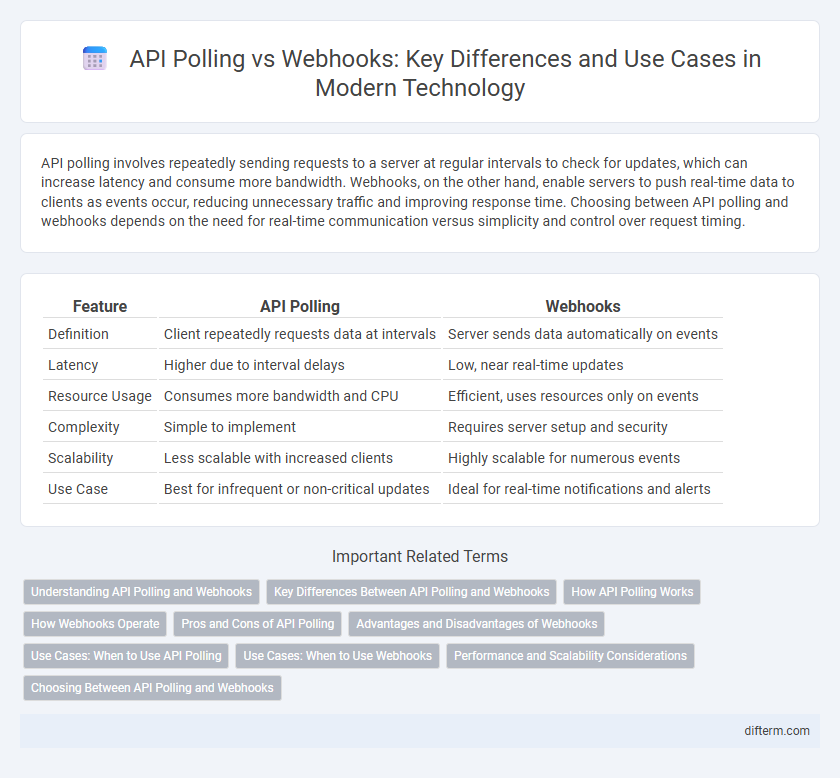API polling involves repeatedly sending requests to a server at regular intervals to check for updates, which can increase latency and consume more bandwidth. Webhooks, on the other hand, enable servers to push real-time data to clients as events occur, reducing unnecessary traffic and improving response time. Choosing between API polling and webhooks depends on the need for real-time communication versus simplicity and control over request timing.
Table of Comparison
| Feature | API Polling | Webhooks |
|---|---|---|
| Definition | Client repeatedly requests data at intervals | Server sends data automatically on events |
| Latency | Higher due to interval delays | Low, near real-time updates |
| Resource Usage | Consumes more bandwidth and CPU | Efficient, uses resources only on events |
| Complexity | Simple to implement | Requires server setup and security |
| Scalability | Less scalable with increased clients | Highly scalable for numerous events |
| Use Case | Best for infrequent or non-critical updates | Ideal for real-time notifications and alerts |
Understanding API Polling and Webhooks
API polling involves repeatedly sending requests to a server at regular intervals to check for new data, which can lead to increased latency and unnecessary resource consumption. Webhooks provide a more efficient alternative by allowing servers to automatically push real-time updates to clients as events occur, reducing overhead and improving responsiveness. Understanding the trade-offs between polling and webhooks is crucial for optimizing application performance and resource management.
Key Differences Between API Polling and Webhooks
API polling relies on repeated requests from the client to the server at regular intervals to check for new data, leading to increased latency and higher resource consumption. Webhooks enable servers to send real-time notifications to clients instantly when an event occurs, reducing unnecessary network traffic and improving efficiency. Key differences include polling's client-driven data retrieval versus webhooks' server-driven event pushing, impacting responsiveness and scalability in application design.
How API Polling Works
API polling works by continuously sending requests from a client to a server at regular intervals to check for new data or updates. This method relies on the client to initiate communication, which can lead to increased latency and higher resource consumption due to frequent repeated requests. Despite being simple to implement, API polling is less efficient compared to event-driven alternatives like webhooks, especially in scenarios requiring real-time data synchronization.
How Webhooks Operate
Webhooks operate by sending real-time HTTP POST requests from a server to a specified URL when specific events occur, enabling immediate data transmission without continuous client requests. This event-driven mechanism reduces server load and latency compared to API polling, which requires repeated querying. By establishing a persistent connection listener, webhooks ensure efficient and timely updates in applications such as payment processing, messaging platforms, and IoT device management.
Pros and Cons of API Polling
API polling offers simplicity in implementation and provides control over the request frequency, making it suitable for systems with predictable data update intervals. However, it can lead to increased server load and higher latency, as clients continuously send requests regardless of data changes. Frequent polling risks hitting API rate limits and results in inefficient bandwidth usage compared to event-driven Webhooks that deliver real-time updates.
Advantages and Disadvantages of Webhooks
Webhooks provide real-time data delivery, reducing server load and latency compared to API polling, which relies on periodic requests that can cause unnecessary traffic and delays. They enable efficient, event-driven communication with lower resource consumption, but depend heavily on stable network connections and require secure endpoint management to prevent vulnerabilities. However, implementing webhooks may pose challenges in error handling and retries, unlike polling, which inherently checks for updates at set intervals.
Use Cases: When to Use API Polling
API polling is ideal for applications requiring regular updates from services lacking webhook support or when real-time data is not critical. It suits scenarios with predictable, low-frequency data checks, such as monitoring system statuses or retrieving batch data updates. Polling remains effective for legacy systems or when network configurations restrict incoming webhook requests.
Use Cases: When to Use Webhooks
Webhooks are ideal for real-time event notifications, such as payment confirmations, chat message updates, and inventory changes, where immediate data synchronization is critical. They reduce server load and latency by eliminating the need for constant API polling, making them efficient for applications with unpredictable or sporadic event occurrences. Webhooks excel in systems requiring instantaneous reactions to specific triggers, enhancing responsiveness and resource optimization in event-driven architectures.
Performance and Scalability Considerations
API polling continuously requests data at regular intervals, which can lead to increased latency and higher server load, negatively impacting performance and scalability. Webhooks provide real-time data updates by pushing information only when events occur, significantly reducing unnecessary requests and improving resource efficiency. For large-scale systems, webhooks enhance scalability by minimizing redundant traffic and enabling faster data synchronization across distributed services.
Choosing Between API Polling and Webhooks
Choosing between API polling and webhooks depends on real-time data needs and system resource constraints. Webhooks provide instant notifications by pushing data updates, reducing server load and latency, ideal for event-driven architectures. API polling requires continuous requests at set intervals, increasing bandwidth usage and response delays but offers control when webhook support is unavailable or unreliable.
API polling vs Webhooks Infographic

 difterm.com
difterm.com